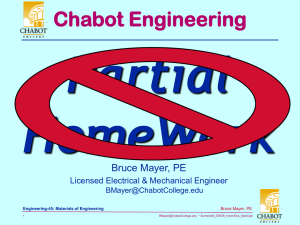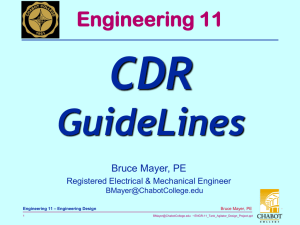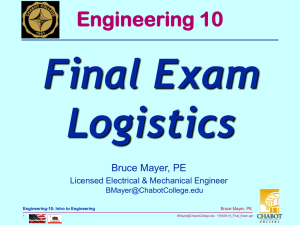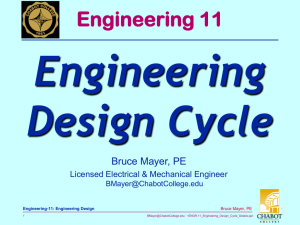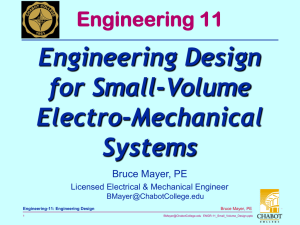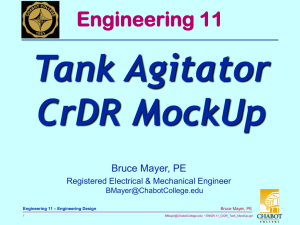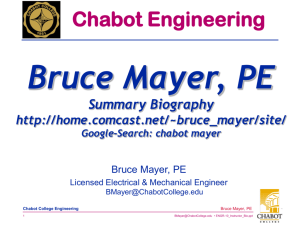Human Factors & Ergonomics Engineering 11 Bruce Mayer, PE
advertisement
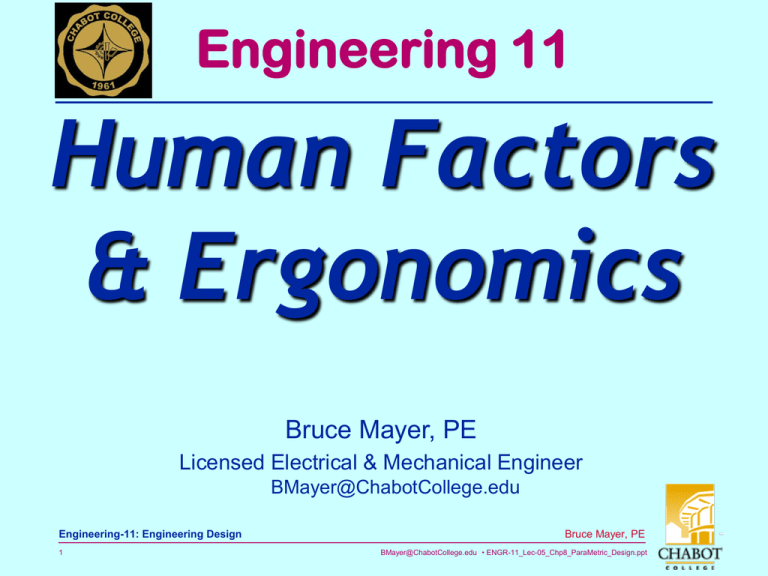
Engineering 11 Human Factors & Ergonomics Bruce Mayer, PE Licensed Electrical & Mechanical Engineer BMayer@ChabotCollege.edu Engineering-11: Engineering Design 1 Bruce Mayer, PE BMayer@ChabotCollege.edu • ENGR-11_Lec-05_Chp8_ParaMetric_Design.ppt OutLine Human Factors Human limitations, abilities Human-Machine System Sensory input limitations Decision making limitations Summary Engineering-11: Engineering Design 2 Bruce Mayer, PE BMayer@ChabotCollege.edu • ENGR-11_Lec-05_Chp8_ParaMetric_Design.ppt Definition Human Factors What is Human Factors Engineering (a.k.a. Human Factors)? The Design for the abilities, limitations, and other physiological or behavioral characteristics of humans which affect the use & operation of tools, machines, systems, tasks, jobs, and environments. Engineering-11: Engineering Design 3 Bruce Mayer, PE BMayer@ChabotCollege.edu • ENGR-11_Lec-05_Chp8_ParaMetric_Design.ppt Consider HF Early in the Design Formulation Preliminary Design Configuration Parametric Embodiment Design Human Factors Concept Detail Engineering-11: Engineering Design 4 Bruce Mayer, PE BMayer@ChabotCollege.edu • ENGR-11_Lec-05_Chp8_ParaMetric_Design.ppt Common Customer Requirements Typical Human Functional Requirements • User-Friendliness • Convenience • Effectiveness • Efficiency • Increased productivity Engineering-11: Engineering Design 5 Typical Human Values Requirements • Improved safety • Reduced worker fatigue or stress • Increased comfort • Greater user acceptance • Increased job satisfaction • Improved quality of life Bruce Mayer, PE BMayer@ChabotCollege.edu • ENGR-11_Lec-05_Chp8_ParaMetric_Design.ppt Starting Pt Activity Analysis Human Factors Design often begins with an Activity, or InterAction, Analysis for the Types of People Who will Interact with the Designed Product in some form. Interaction Type examples • People who BUILD the Product • People who USE the Product • People who DISPOSE of the Product Engineering-11: Engineering Design 6 Bruce Mayer, PE BMayer@ChabotCollege.edu • ENGR-11_Lec-05_Chp8_ParaMetric_Design.ppt Example Bike USER (Rider) Activity Analysis for a BiCycle Rider • • • • • • removes the bicycle from storage, climbs onto the bike and pedals down the street, pushes the handle bar to steer around a dog in the street, slows down by grasping handbrake lever and squeezing, steers to the side of the road to let car pass by, pushes the shift lever to a lower gear decreasing pedal force to climb hill, • squeezes brake lever to stop at the top of the hill, dismounts, • walks the bike to roadside and enjoys the view. Engineering-11: Engineering Design 7 Bruce Mayer, PE BMayer@ChabotCollege.edu • ENGR-11_Lec-05_Chp8_ParaMetric_Design.ppt Rider↔Bike InterActions Use eyes to see Hands/Arms to pick up Foot and Leg to climb up onto seat Hand(s) for braking Feet and Legs to provide propulsion Ears to Hear traffic or dogs Fingers to shift gears Inner Ear/Balance to stay upright Engineering-11: Engineering Design 8 Bruce Mayer, PE BMayer@ChabotCollege.edu • ENGR-11_Lec-05_Chp8_ParaMetric_Design.ppt Considerations in HF Design Types of People who Basic Machine Interact with a Operation Machine • Takes INPUTS • Builder/Maker – person who produces the product • Shipper/Installer • User • Maintainer (repair persons) • Disposer Engineering-11: Engineering Design 9 • Performs a Productive FUNCTION • Produces OUTPUTS – Value-Added OutPut (Desired) – ByProducts (Not Desired) May be nonBenign Bruce Mayer, PE BMayer@ChabotCollege.edu • ENGR-11_Lec-05_Chp8_ParaMetric_Design.ppt Typical S8-0701 Ergonomic Measurement S8 Spec Focuses on • Installer/Disposer • User • Maintainer SEMI S8 GuideLines apply to the design, operation, maintenance, and service of semiconductor manufacturing equipment, as well as, to a limited extent, equipment installation Engineering-11: Engineering Design 10 Bruce Mayer, PE BMayer@ChabotCollege.edu • ENGR-11_Lec-05_Chp8_ParaMetric_Design.ppt SEMI S8 Activity Analysis & Conformance Review Engineering-11: Engineering Design 11 Bruce Mayer, PE BMayer@ChabotCollege.edu • ENGR-11_Lec-05_Chp8_ParaMetric_Design.ppt Human-Machine Sensory Limits Makes Decisions Input Sensory signals Output Muscle force, torque, motion Human - Machine interface Output Performance displays Input Control signals Perform Function(s) Engineering-11: Engineering Design 12 Bruce Mayer, PE BMayer@ChabotCollege.edu • ENGR-11_Lec-05_Chp8_ParaMetric_Design.ppt Sensory input limitations Sight Hearing Smell Taste Touch • Kinesthetic (People can get a “Feel” for a good Tennis Stroke) • Vestibular (Response to whole-body Accelerations) Engineering-11: Engineering Design 13 Bruce Mayer, PE BMayer@ChabotCollege.edu • ENGR-11_Lec-05_Chp8_ParaMetric_Design.ppt Sight Limitations Near/Far focusing Speed (persistence of vision) Night vision/illumination “perceive” (optical illusions, psychological?) Color blindness Engineering-11: Engineering Design 14 Bruce Mayer, PE BMayer@ChabotCollege.edu • ENGR-11_Lec-05_Chp8_ParaMetric_Design.ppt Hearing Limitations Frequencies Amplitude “perceive” (hear, but not know what caused…) Understand (language) Masking by ambient/environmental noise Engineering-11: Engineering Design 15 Bruce Mayer, PE BMayer@ChabotCollege.edu • ENGR-11_Lec-05_Chp8_ParaMetric_Design.ppt Touch • Kinesthetic • Vestibular Tactile stimulation of skin • Sharp, hot, smooth, electrically charged Radiation (heat) Kinesthetically feel joint/muscle movement • “Good” golf/tennis swing, skiing, PoleVault Vestibular (inner ear) • Sense of balance Engineering-11: Engineering Design 16 Bruce Mayer, PE BMayer@ChabotCollege.edu • ENGR-11_Lec-05_Chp8_ParaMetric_Design.ppt Sensory OverLoad Too much input, too fast Confusing Sensory Fatigue Engineering-11: Engineering Design 17 Bruce Mayer, PE BMayer@ChabotCollege.edu • ENGR-11_Lec-05_Chp8_ParaMetric_Design.ppt Human-Machine Decision Limits Makes Decisions Input Sensory signals Output Muscle force, torque, motion Human - Machine interface Output Performance displays Input Control signals Perform Function(s) Engineering-11: Engineering Design 18 Bruce Mayer, PE BMayer@ChabotCollege.edu • ENGR-11_Lec-05_Chp8_ParaMetric_Design.ppt Decision making limitations DECISION RAMIFICATIONS InputInfo → MakeDecision → TakeAction • Action Taken is often called the “OutPut” Example • Input: See politician in the road • Decision: Decide to hit or avoid? • Output (TakeAction): Steer Around OR Brake OR Accelerate Engineering-11: Engineering Design 19 Bruce Mayer, PE BMayer@ChabotCollege.edu • ENGR-11_Lec-05_Chp8_ParaMetric_Design.ppt ReAction Times Fast & Slow SIMPLE reaction time • one stimulus, same response – i.e. “knee jerk”, trained response e.g.; See Dog Run into Road Hit Brakes!!! CHOICE reaction time • several stimuli, different responses – i.e., process multiple, and possibly conflicting, signals; then Take “some” (wrong?) action e.g. power plant malfunction Engineering-11: Engineering Design 20 Bruce Mayer, PE BMayer@ChabotCollege.edu • ENGR-11_Lec-05_Chp8_ParaMetric_Design.ppt Human-Machine Output Limits Makes Decisions Input Sensory signals Output Muscle force, torque, motion Human - Machine interface Output Performance displays Input Control signals Perform Function(s) Engineering-11: Engineering Design 21 Bruce Mayer, PE BMayer@ChabotCollege.edu • ENGR-11_Lec-05_Chp8_ParaMetric_Design.ppt Human Mechanics Forces (e.g. arms, legs, hands, fingers) Range of motion (Kinematics) Energy Expenditure Control - Ability Size (abilities/limitations) Engineering-11: Engineering Design 22 Bruce Mayer, PE BMayer@ChabotCollege.edu • ENGR-11_Lec-05_Chp8_ParaMetric_Design.ppt Force Mechanics Engineering-11: Engineering Design 23 Bruce Mayer, PE BMayer@ChabotCollege.edu • ENGR-11_Lec-05_Chp8_ParaMetric_Design.ppt Range of Motion Engineering-11: Engineering Design 24 Bruce Mayer, PE BMayer@ChabotCollege.edu • ENGR-11_Lec-05_Chp8_ParaMetric_Design.ppt Energy/Power Expenditure Table 11.2 Mean value energy expenditure per day for various occupations (adapted from Sanders and McCormick, 1993) Energy Expended Occupation (kcal/day) Construction worker (male) 3000 Steel worker (male) 3280 Coal miner (male) 3660 Housewives 2090 University males/females 2930/2290 Engineering-11: Engineering Design 25 Bruce Mayer, PE BMayer@ChabotCollege.edu • ENGR-11_Lec-05_Chp8_ParaMetric_Design.ppt Human Sizes The study of Anthropometrics (human measurement) is concerned with the physical sizes and shapes of humans. Of particular interest are the differences between and among different populations (men vs. women, Northern Europeans vs. Japanese, etc.) • Most typical “Boundary Conditions” – 5th %-tile Asian Female – 95th %-tile American Male Engineering-11: Engineering Design 26 Bruce Mayer, PE BMayer@ChabotCollege.edu • ENGR-11_Lec-05_Chp8_ParaMetric_Design.ppt 95th %-tile American Male 5th %-tile Asian Female Engineering-11: Engineering Design 27 Bruce Mayer, PE BMayer@ChabotCollege.edu • ENGR-11_Lec-05_Chp8_ParaMetric_Design.ppt Anthropometrics American Woman Engineering-11: Engineering Design 28 Bruce Mayer, PE BMayer@ChabotCollege.edu • ENGR-11_Lec-05_Chp8_ParaMetric_Design.ppt Control-Ability Engineering-11: Engineering Design 29 Bruce Mayer, PE BMayer@ChabotCollege.edu • ENGR-11_Lec-05_Chp8_ParaMetric_Design.ppt Human-Machine System Summary Makes Decisions Input Sensory signals Output Muscle force, torque, motion Human - Machine interface Output Performance displays Input Control signals Perform Function(s) Engineering-11: Engineering Design 30 Bruce Mayer, PE BMayer@ChabotCollege.edu • ENGR-11_Lec-05_Chp8_ParaMetric_Design.ppt Visual & Auditory Displays Visual Display Types • indicator lights • continuous readout gages • bells • buzzers • horns • digital counters • graphical panels • Sirens • tones, and • electronic devices that speak Engineering-11: Engineering Design 31 Audible Display Types Bruce Mayer, PE BMayer@ChabotCollege.edu • ENGR-11_Lec-05_Chp8_ParaMetric_Design.ppt Display GuideLines Conspicuity – The display should be conspicuous in that it should be prominently located, novel and relevant. Emphasis – Important words should be visually emphasized. Legibility – Character fonts, size and contrast should be exploited. Engineering-11: Engineering Design 32 Bruce Mayer, PE BMayer@ChabotCollege.edu • ENGR-11_Lec-05_Chp8_ParaMetric_Design.ppt Display GuideLines Intelligibility – Succinctly tell the operator what the hazard is and how to fix it. Visibility – The display should be visible in all lighting conditions including day or night. Maintainability – The display should resist aging, wear and vandalism. Standardization – Standard words and symbols Engineering-11: Engineering Design 33 Bruce Mayer, PE BMayer@ChabotCollege.edu • ENGR-11_Lec-05_Chp8_ParaMetric_Design.ppt Design For Fit Gold Standard Design to Accommodate Human Interaction for 5th Percentile Asian Female to 95th Percentile American Male Use anthropometric data Engineering-11: Engineering Design 34 Bruce Mayer, PE BMayer@ChabotCollege.edu • ENGR-11_Lec-05_Chp8_ParaMetric_Design.ppt Example Ergonomic Design 95th Percentile American Male 5th Percentile Asian Female Engineering-11: Engineering Design 35 Bruce Mayer, PE BMayer@ChabotCollege.edu • ENGR-11_Lec-05_Chp8_ParaMetric_Design.ppt WorkSpace Design Climate • air temperature, humidity • airborne particulates • odors and harmful vapors Illumination • light intensity, color content • glare/ reflection Engineering-11: Engineering Design 36 Noise • sound level, frequency, duration, • fluctuations in level or frequency Motion • whole body vib., freq. and intensity • head motions (motion sickness) Bruce Mayer, PE BMayer@ChabotCollege.edu • ENGR-11_Lec-05_Chp8_ParaMetric_Design.ppt Summary ErgoNomics Customer requirements include HF Sensory input limitations Decision making limitations Human muscle output limitations • Forces, range of motion, energy, Anthropometrics Design for fit Workspace guidelines Engineering-11: Engineering Design 37 Bruce Mayer, PE BMayer@ChabotCollege.edu • ENGR-11_Lec-05_Chp8_ParaMetric_Design.ppt All Done for Today Formula SAE Anthropometric Data Engineering-11: Engineering Design 38 Bruce Mayer, PE BMayer@ChabotCollege.edu • ENGR-11_Lec-05_Chp8_ParaMetric_Design.ppt Engineering 11 Appendix Bruce Mayer, PE Registered Electrical & Mechanical Engineer BMayer@ChabotCollege.edu Engineering-11: Engineering Design 39 Bruce Mayer, PE BMayer@ChabotCollege.edu • ENGR-11_Lec-05_Chp8_ParaMetric_Design.ppt SEMI S8 Goals These guidelines provide ergonomics design principles and considerations for semiconductor manufacturing equipment. The purpose of these guidelines is to promote compatibility between the user and the equipment in the IC manufacturing environment. The following general principles are integral to the ergonomics design and evaluation of equipment: • The equipment should be designed to optimize safety by distributing tasks. Tasks should be distributed among hardware, software, and users to make the best use of their respective capabilities and to minimize limitations and hazards. Appropriate distribution of tasks will also optimize performance. • Equipment should be designed to minimize potential for errors and mishaps, by conforming to users' expectations. • The equipment design should reduce fatigue and injury by fitting the equipment to the expected body size, strength, and range of motion characteristics of the user population. Such design will also facilitate task performance. Engineering-11: Engineering Design 40 Bruce Mayer, PE BMayer@ChabotCollege.edu • ENGR-11_Lec-05_Chp8_ParaMetric_Design.ppt Human Machine InterAction Engineering-11: Engineering Design 41 Bruce Mayer, PE BMayer@ChabotCollege.edu • ENGR-11_Lec-05_Chp8_ParaMetric_Design.ppt
